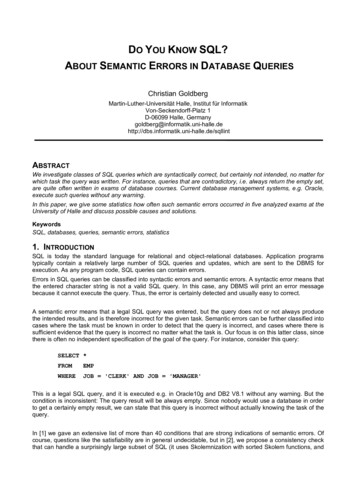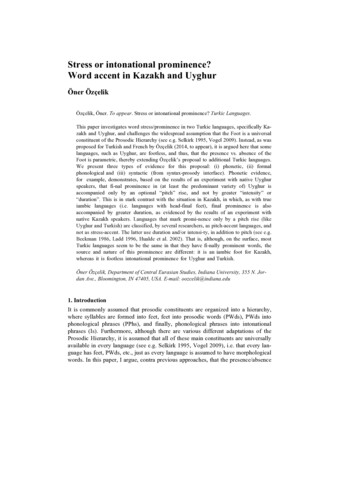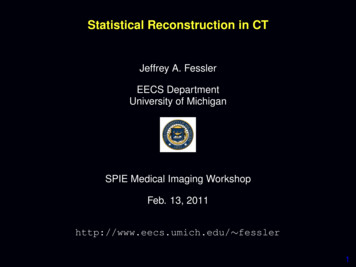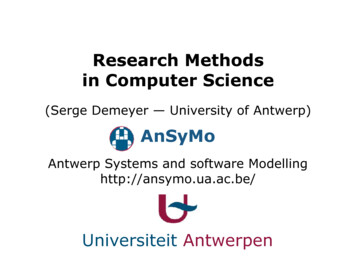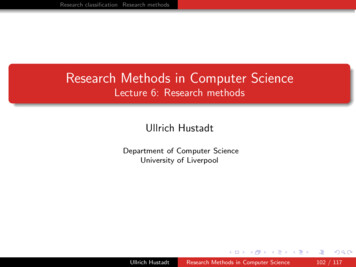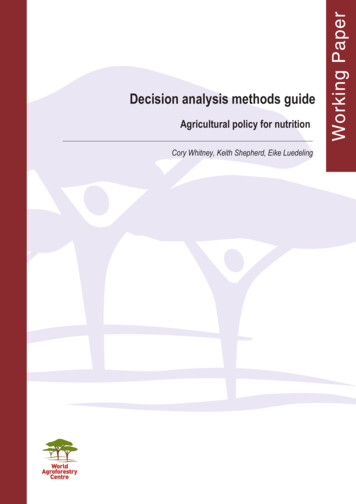
Transcription
Decision analysis methods guideAgricultural policy for nutritionCory Whitney, Keith Shepherd, Eike Luedeling
Decision analysis methods guideAgricultural policy for nutritionCory Whitney, Keith Shepherd, Eike Luedeling
LIMITED CIRCULATIONCorrect citation: Whitney C, Shepherd K, Luedeling E. 2018. Decision analysis methods guide; Agriculturalpolicy for nutrition. Working Paper No. 275. World Agroforestry Centre, s in the Working Paper Series aim to disseminate interim results on agroforestry research and practices andstimulate feedback from the scientific community. Other publication series from the World Agroforestry Centreinclude the Trees for Change series, Technical Manuals and Occasional Papers.Published by the World Agroforestry CentreUnited Nations AvenuePO Box 30677, GPO 00100Nairobi, KenyaTel: 254(0)20 7224000, via USA 1 650 833 6645Fax: 254(0)20 7224001, via USA 1 650 833 6646Email: worldagroforestry@cgiar.orgInternet: www.worldagroforestry.org World Agroforestry Centre 2018Working Paper No. 275The views expressed in this publication are those of the authors and not necessarily those of the WorldAgroforestry Centre.Articles appearing in this publication may be quoted or reproduced without charge, provided the source isacknowledged.All images remain the sole property of their source and may not be used for any purpose without writtenpermission of the source.Some parts of this working paper are shared as supplementary materials in the publication: Whitney CW,Lanzanova D, Muchiri C, Shepherd KD, Rosenstock TS, et al. 2018. Probabilistic decision tools fordetermining impacts of agricultural development policy on household nutrition. Earth’s Futureii
About the authorsCory Whitney, Centre for Development Studies (ZEF), University of Bonn, Genscherallee 3, 53113Bonn, Germany/World Agroforestry Centre (ICRAF), PO Box 30677, Nairobi 00100, KenyaKeith Shepherd, World Agroforestry Centre (ICRAF), PO Box 30677, Nairobi 00100, KenyaEike Luedeling, University of Bonn, Institut für Nutzpflanzenwissenschaften und Ressourcenschutz(INRES), Auf dem Hügel 6, 53121 Bonn, Germany/World Agroforestry Centre (ICRAF), PO Box30677, Nairobi 00100, Kenyaiii
AbstractIt is often very difficult to make accurate projections about how interventions will affect the realworld and to use such projections to develop effective implementation plans, monitor progress andevaluate project impacts. This is due to a variety of factors including lack of data, complex impactpathways and risks and uncertainties that are difficult to factor into intervention planning. Scientificapproaches to produce reliable impact projections are rarely applied in agricultural development, butDecision Analysis techniques commonly used in other fields have the potential to improvedevelopment decisions. This working paper outlines a Decision Analysis approach that can helpdecision makers efficiently allocate resources to enhance the effectiveness of policy decisions.The procedures outlined in this publication feature the construction of causal models – models thatdescribe the mechanisms through which intervention impacts will be delivered – that are codeveloped by experts, stakeholders and analysts through facilitated participatory processes. Thesemodels are then formalized as Bayesian Network (BN) models, a modelling approach that has beenwidely applied in a range of disciplines, including medical sciences, genetics, environmental sciencesand legal reasoning. BNs allow for the formal representation of causal models, such as interventionimpact pathways. They can work effectively with incomplete information, combine expert knowledgewith other sources of information and allow for adequate consideration of risk.This paper illustrates the use of participatory workshops that convene experts on the systems,stakeholders involved in ongoing or prospective projects and analysts. These teams can jointlydevelop impact pathways for the interventions, which can be formalized into quantitative BN models.After several rounds of feedback elicitation and the inclusion of data from experts and other sources,stochastic simulations can be run to determine the likely impacts of the interventions. Results can bepresented back to stakeholders for feedback.Through the tools presented in this working paper, critical uncertainties in the models of interventionimpact pathways can be identified. These high-value variables can determine uncertainty aboutproject outcomes. Further measurement or disaggregation of these variables can support decisionmaking processes.By demonstrating improved intervention decisions with little additional investment and improvedtools for intervention decision modelling, we hope that this approach will be widely adopted and usedto enhance the efficacy of development activities.KeywordsDecision Analysis, Bayesian Networks, Probabilistic Modelling, Nutrition, Hunger, MicronutrientDeficiencyiv
AcknowledgementsThis work was funded by Competitive Research Grants to Develop Innovative Methods and Metricsfor Agriculture and Nutrition Actions (IMMANA), grant number 1.36. IMMANA is funded by theUK government. We also acknowledge the support of the CGIAR Research Program on ‘Water, Landand Ecosystems’.v
Table of ContentsAbout the authors . iiiAbstract . ivAcknowledgements .vList of figures . viList of tables . viiList of acronyms and abbreviations . viiiIntroduction .1Predicting impacts of agriculture for nutrition activities .1Decision Analysis .3Bayesian Networks .4Steps in the Decision Analysis process .6Decision framing .6Generating a graphical model .6Calibration training .8Model quantification .9Example of a Bayesian Network.11Value of Information analysis .13The decisionSupport package .16Monte Carlo analysis .22The AgenaRisk software .23Creating a Bayesian Network in AgenaRisk .23Value of Information calculation in AgenaRisk .24Conclusion .26References .27List of figuresFigure 1. Summary of the decision modelling process . 3Figure 2. The process used for eliciting graphical representations of decisions from expert groups tobe used in developing a Bayesian Network . 8Figure 3. Example of a tool for translating expert knowledge into a Conditional Probability Table(CPT) for use in a Bayesian Network . 10Figure 4. Example of a Bayesian Network for household nutrition impacts of a policy strategy (Vision2040) in Uganda. 12Figure 5. Example of a filled input sheet for translating expert knowledge on Food Preferences . 17Figure 6. Interface of AgenaRisk software with example model of probabilities for different states ofDiversity of household diets under the Ugandan Government’s decision to implement Vision2040 . 23Figure 7. Example of a utility node as a partitioned expression filled with arithmetic values in theAgenaRisk software . 24Figure 8. Example of the input sheet for the VoI Analysis in the AgenaRisk software . 25vi
List of tablesTable 1. Calculation of the expected value of perfect information for a Bayesian Network model ofutility values for value of diverse diets . 14Table 2. Conditional probability table from the decisionSupport R code . 18Table 3. Legend for columns of the conditional probability table from the decisionSupport R code . 19Table 4. Conditional probability table for Food Preferences under Uganda’s Vision 2040 developmentdecision. Strength of response . 20Table 5. Probabilities for different states of Food Preferences under the scenario that the UgandanGovernment’s Vision 2040 is implemented . 22vii
List of acronyms and MNDNPTUKVoIZEFApplied Information EconomicsBayesian NetworkConfidence IntervalConditional Probability TablesExpert Knowledge ElicitationExpected Monetary ValueExpected Value or Perfect InformationWorld Agroforestry CentreInnovative Methods and Metrics for Agriculture and Nutrition ActionsInstitut für Nutzpflanzenwissenschaften und RessourcenschutzMicronutrient DeficiencyNode Probability TableUnited KingdomValue of InformationCentre for Development Studiesviii
IntroductionThe development community faces increasing demand to credibly link research and developmentactivities with progress towards the envisioned outcomes (Shepherd, Luedeling and Whitney, underreview). Improved planning tools for interventions that target complex systems are urgently needed,especially in developing countries where data are scarce and uncertainties about decision outcomesare large. However, especially where quantitative impact predictions are requested, stakeholders areoften left guessing about development outcomes, because they lack reliable tools to forecast impacts.Methodologies that address these uncertainties could transform the way development is done andgreatly enhance the efficacy of its activities. Such methods could stimulate thorough scrutiny ofresearch priorities and direct resources to where they lead to the greatest impacts (Luedeling andShepherd, 2016). However, for this positive effect to materialize, the development community needsbetter approaches for planning for impact.One of the central difficulties in planning for impact is dealing with uncertainty. It is rarely possible toaccurately predict the impacts of agriculture for nutrition actions and other types of interventions.Many of the important factors that determine these impacts, such as adoption rates, yield increases,the performance of a particular tree or crop in a new environment and future weather, are highlyuncertain. Additionally, many development interventions are implemented in risky environments,where extreme weather events, conflict, poor anticipation of cultural preferences, politicalinterference or other risk factors can dramatically disrupt progress at any time (Luedeling et al.,2015).Making impact projections in this environment, especially where precise numbers are expected, isvery difficult and researchers and development workers often find themselves in an ethical quagmire,torn between the perceived need to honestly evaluate risks and the temptation to let wishful thinkingguide their estimates. The latter may lead to overly optimistic assumptions and high impactp
would be difficult or impossible to predict with precision. Some examples of these difficult-to-measure factors are the so-called ‘intangible’ factors, such as people’s perceptions of healthy food and their food preferences. The nutritional status of a country’s population is determined by many such . 2 factors, including, not only, the nutritional value of the food people eat, but .




